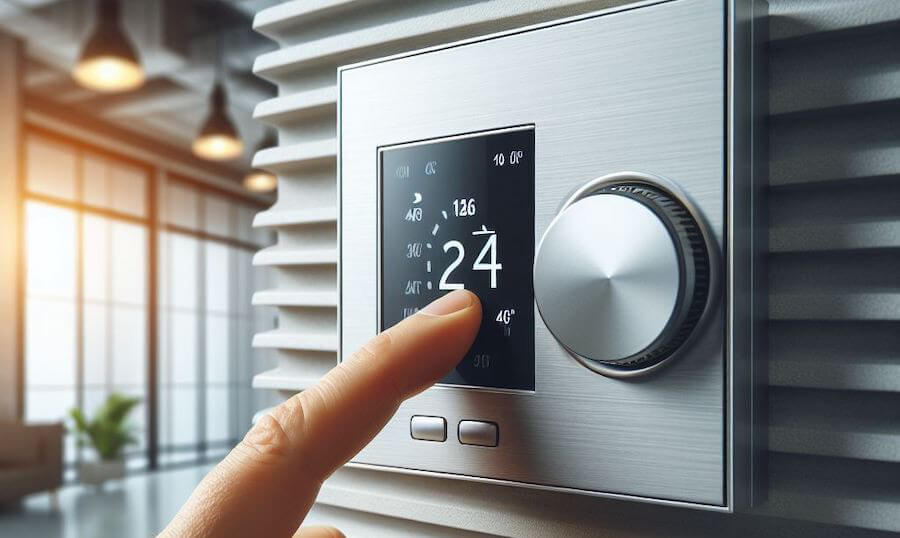Table of Contents
Understanding Uncomfortable Work Environments
Impact of Non-Radiative Heating Solutions on Comfort
The Relationship Between Temperature and Productivity
Strategies for Achieving Ideal Workplace Temperature
Navigating the Temperature-Productivity Nexus
Is your office thermostat playing a role in your teams’ performance? It might very well be. The surrounding ambiance may seem like a trivial factor, but research shows otherwise – temperature greatly affects work productivity more than we ever thought it did. In this blog post, we dive into the details of how everything from precision tasks to creative brainstorming can hinge on whether you’re warm enough or too cold. As leaders in infrared heating technology at Lamina Heat, we’ll leverage our thermal expertise to untangle this curious relationship between productivity and temperature. Propel your team’s potential by tuning into the right climate control. Your optimal office temperature might just be a few degrees away.
Temperature can have a significant impact on productivity. Research suggests that excessively hot or cold temperatures can make it difficult to concentrate and perform tasks effectively. It is generally recommended to maintain office temperatures within a range of 68 to 76 degrees Fahrenheit (20 to 24 Celsius), as this provides a comfortable environment conducive to optimal productivity.
Understanding Uncomfortable Work Environments
Uncomfortable work environments encompass more than just extreme air temperatures. They also include poor ventilation, humidity issues, noise levels, lighting conditions, and other factors that can impact an employee’s comfort, safety, development, and well-being.
When employees are uncomfortable in their workspace, experiencing symptoms such as excessive sweating and struggling to manage their workload, it not only affects their physical health but also their mental state and overall job satisfaction. A comfortable work environment, with attention to safety considerations, is crucial for promoting productivity and ensuring that employees can perform their best. In addition to the myriad factors contributing to uncomfortable work environments, the control of air temperature, specifically addressing heat and cold, emerges as one of the most pivotal and manageable aspects for ensuring safety. While poor ventilation, high humidity, excessive noise, inadequate lighting, and other elements certainly play roles in creating discomfort, the ease with which heat and cold can be regulated makes them particularly impactful areas for immediate improvement.

Maintaining an optimal temperature range is fundamental to cultivating a work atmosphere where employees feel both physically and mentally at ease, ensuring their safety while managing their workload effectively. Heat and cold, being tangible and quantifiable variables, can be swiftly adjusted to align with the preferences and comfort levels of the workforce.
The Impact of Non-Radiative Heating Solutions on Workplace Comfort and Health
It’s worth highlighting the potential effects of specific heating solutions, especially non-radiative ones, which may unintentionally introduce discomfort into the workplace. Unlike radiant heating systems, non-radiative heaters can lead to a drying effect on air, which could have implications for the well-being and productivity of employees.
The consequence of drying out the air is straightforward, directly influencing the comfort levels of the workforce. As the air loses moisture, employees may experience physical discomfort, including dry skin, irritated eyes, and potential respiratory issues. This discomfort can also extend to mental well-being, contributing to increased stress levels and a decline in overall job satisfaction.
Furthermore, the drying effect on the air can impact productivity. When the workplace environment lacks optimal humidity levels, individuals may find it challenging to concentrate on tasks, potentially leading to reduced efficiency and output. The discomfort induced by dry air may also result in fatigue, which could further impede physical movement and cognitive functions.
A noteworthy concern is the potential increase in the incidence of sickness among workers. Dry air can create an environment conducive to the spread of airborne viruses, making employees more susceptible to respiratory infections. This may result in higher rates of absenteeism, disrupting work performance, and impacting overall productivity within the organisation.
This nuanced understanding of the impact of non-radiative heating solutions reveals a broader spectrum of workplace climate control considerations. While addressing the ambient temperature is crucial, it is equally important to evaluate the effects of heating solutions on air quality. Achieving a healthy and productive work environment involves a thoughtful approach that considers both temperature and air quality, recognizing their interconnected roles in shaping the overall workplace experience.
The Relationship Between Temperature and Productivity
Temperature plays a crucial role in our daily lives, including the workplace. Numerous studies have explored the relationship between room temperature and productivity, shedding light on its impact on employee performance. A balance must be struck to create an optimal environment that promotes efficiency and wellbeing. Let’s delve deeper into the effects of heat and cold on job performance.
- In 2004, a month-long research study conducted by Cornell University at the Insurance Office of America’s headquarters in Orlando, Florida, revealed a notable correlation: workers in colder environments tend to make more errors, potentially leading to a 10% increase in hourly labor costs for the affected individuals.
- In workplaces that involve manual labour, productivity experiences a decline of up to 4% for each degree increase beyond 27 degrees Celsius (80 degrees Fahrenheit). However, this effect is not observed in highly automated settings.
- According to studies conducted by ASHRAE, maintaining a surface temperature around 55°C strikes the right balance between effectiveness and comfort. When the surface temperature of a radiant heat source exceeds 60°C, the percentage of people dissatisfied with the sensation increases rapidly.
Temperature has a significant influence on productivity in the workplace. It is crucial to find an optimal balance between heat and cold to create an environment that promotes both efficiency and employee wellbeing.
The Impact of Heat on Workplace Performance
As temperatures soar, the intricacies of maintaining optimal workplace productivity become more apparent. The effects of excessive heat extend far beyond mere discomfort, delving into a multifaceted challenge that impacts both the physical and cognitive dimensions of employee performance.
In the realm of physical well-being, the rise in temperature induces a spectrum of challenges. Physical discomfort becomes pervasive, and the prolonged exposure to high temperatures can lead to fatigue, a sensation that not only impedes physical movement but also saps the mental energy required for sustained focus. As the mercury climbs, concerns about dehydration and heatstroke become significant factors, particularly in workplaces where cooling measures are insufficient. The relentless discomfort caused by excessive heat manifests as a tangible distraction, diverting employees’ attention from their tasks and hindering their ability to maintain efficiency.

The cognitive toll of high temperatures on workplace performance is equally substantial. Research, including studies conducted by Helsinki University of Technology and Lawrence Berkeley National Laboratory, has emphasised the adverse impact of excessive heat on cognitive abilities. Memory, attention, and reasoning—all critical components of effective job performance—are compromised under the strain of elevated temperatures. As the thermostat inches higher, cognitive functions decline, leading to a decline in overall job performance.
Moreover, the discomfort induced by excessive heat amplifies mental stress, further affecting concentration and focus. The struggle to maintain mental clarity becomes apparent, and decision-making abilities, which are paramount in a professional setting, are notably hampered. The workplace, under the relentless influence of high temperatures, becomes a mental battleground where employees grapple with a persistent fog that clouds their thoughts and impedes their ability to navigate complex tasks.
Beyond the immediate challenges posed by excessive heat, the risk of increased errors in complex tasks rises significantly. Studies, such as those conducted at the Insurance Office of America’s headquarters, demonstrate a direct correlation between elevated office temperatures and a spike in typing errors. The decline in precision and an increase in output errors contribute to a tangible reduction in overall job performance.
The Influence of Cold on Job Efficiency
As temperatures plummet, workplaces encounter a distinctive array of challenges that exert a profound influence on job efficiency. While some individuals may thrive in colder temperatures, others grapple with concentration issues, presenting a dichotomy that can significantly affect overall workplace productivity. The impact of cold on job efficiency extends well beyond the realm of physical discomfort, seeping into cognitive functions and overall employee well-being.

Operating in a cold environment introduces a spectrum of physical discomforts that serve as formidable impediments to job efficiency. Picture attempting to type or write with numb fingers, or enduring constant shivering induced by the chilly atmosphere. These physical challenges not only impede dexterity but also create substantial hurdles for employees attempting to maintain focus on their tasks. The result is a tangible reduction in output and overall work efficiency, as the struggle against physical discomfort becomes a persistent distraction.
Moreover, the influence of cold transcends the physical realm, seeping into cognitive functions and mental clarity. Prolonged exposure to extreme cold engenders feelings of sluggishness and mental fog, casting a shadow over employees’ ability to maintain the requisite mental acuity for complex tasks. The frigid conditions, akin to a mental chill, impact decision-making abilities, leading to a noticeable decline in overall productivity. Navigating intricate tasks becomes a formidable challenge for employees operating in freezing conditions, where the demand for heightened mental focus clashes with the mental haze induced by the cold.
Strategies for Achieving Ideal Workplace Temperature
Striking the perfect balance between a comfortable and productive workplace temperature can be challenging, given the varying comfort temperature for the human body among employees. However, innovative solutions like infrared heaters, with their zonal heating ability, offer a tailored approach to match individual comfort levels.
Initiating open discussions with coworkers and managers about temperature concerns fosters a collaborative environment where employees can express their preferences. Consider the scenario where some find the office too hot and others too cold. In such situations, infrared heaters with zonal heating capabilities become invaluable. These heaters allow individuals to adjust the temperature in their immediate vicinity without affecting the entire room. Those feeling too hot can lower the thermostat, while directional infrared heaters cater to those who find it too cold.
Integrating infrared heaters into smart temperature management systems enables automatic adjustments based on occupancy and desired comfort levels. This approach creates a consistent and comfortable environment throughout the day with minimal energy consumption.
In creating this workplace environment, where temperature fluctuations are seamlessly addressed, infrared heaters play a crucial role. They become a solution for maintaining harmony in the office environment, comparable to a well-tuned orchestra responding to the conductor’s guidance.
Navigating the Temperature-Productivity Nexus
In summary, our examination of workplace temperature’s impact on productivity underscores its significant role. We’ve observed the nuanced effects of both heat and cold on physical and cognitive performance.
Beyond personal comfort preferences, effective temperature management proves to be an essential factor in fostering an environment conducive to optimal work output. From infrared heaters offering zonal control to integrated systems adapting to occupancy levels, practical strategies emerge for achieving a harmonious workplace temperature.
Recognising this reality is not just about comfort but an investment in collective performance, we conclude that temperature, when strategically managed, becomes a crucial component in the orchestration of workplace success!
How does cold specifically affect employee performance?
What are the effects of heat on employee performance?
When exposed to excessive heat, employees may experience physical discomfort and fatigue, leading to decreased productivity. High temperatures can also impair cognitive function and decision-making abilities, as the body diverts energy towards regulating its internal temperature. Additionally, heat can cause dehydration, which negatively impacts concentration and overall mental acuity. However, it is important to note that some studies suggest that moderate exposure to heat can actually enhance employee performance by promoting alertness and increasing blood flow to the brain.

